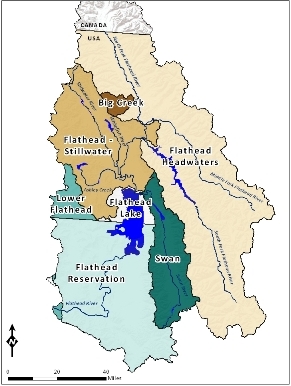Flathead TMDL Project Overview
Draft Document Contacts Project Outreach Nutrient TMDLs Sediment & Temperature TMDLs
Flathead Lake Nutrient Standards Development
Welcome to the Flathead TMDL Project
Flathead Lake drains an area of six million acres stretching from its northern reaches in Canada to the Salish-Kootenai tribal lands and the Swan. Timber, agriculture, tourism, hunting, fishing and a rapidly growing urban and suburban population all depend on clear, cool waters in the rivers, lakes and streams in the Flathead Lake watershed.

Water quality standards have been set to ensure healthy and productive systems for the well being of the natural environment and the people who live, work, and play in Montana. The Montana Department of Environmental Quality (DEQ) assesses the waters, and for those waters not meeting the state standards, develops improvement plans that will lead to the achievement of those standards. This process is known as total maximum daily load (TMDL) development.
DEQ has identified the following primary cause groups as impairments to water quality in the Flathead Lake watershed: nutrients (nitrogen and phosphorus), sediment, PCBs, metals (arsenic, mercury) and thermal modification (temperature).
The TMDL planning process in the Flathead Lake watershed incorporates a combination of a watershed-scale hydrologic model, lake response models, and on-the-ground field efforts to further identify and quantify pollutant contributions from all significant sources. Used in combination, these methods will yield the best available picture of the current water quality conditions and reasons for problems.
TMDLs have already been completed for Flathead Lake (Phase I), the Swan River watershed, and the Flathead-Stillwater and Flathead Headwaters TMDL Planning Areas. These documents can be found on DEQ's Final TMDL Documents webpage. Currently, DEQ is in the process of developing numeric nutrient standards for Flathead Lake after which Phase II nutrient allocations will be developed. Recent monitoring has also been conducted to address the PCB, arsenic, and mercury impairments in the watershed.
The result of this overall process will be individual TMDLs for all impaired rivers and lakes, plus a comprehensive understanding of how nutrient inputs are affecting Flathead Lake.
Flathead TMDL Project Overview
Draft TMDL Document Project Contacts Project Outreach Nutrient TMDLs Sediment & Temperature TMDLs
Flathead Lake Nutrient Standards Development